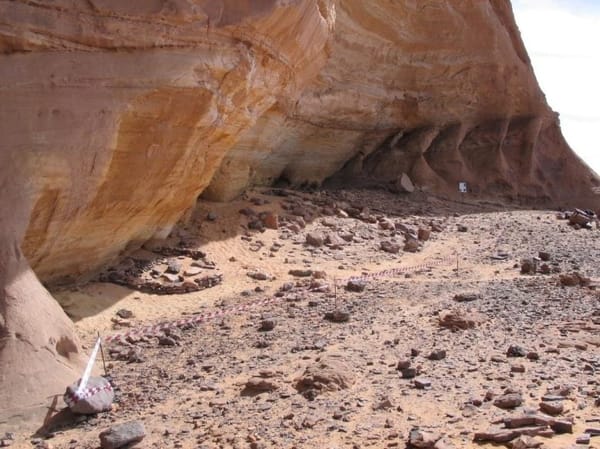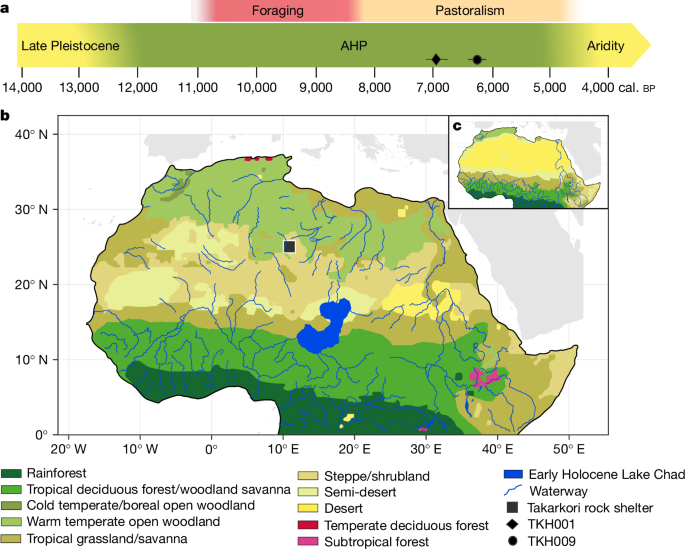Unearthing North African Ancestry: Prehistoric DNA from the Green Sahara





The journey back to a time when the Sahara, now one of Earth's most arid regions, was a thriving savanna known as the Green Sahara, reveals one of humanity's most remarkable transformations. Thanks to the African Humid Period (AHP), which occurred approximately 14,800 to 5,500 years ago, this era was marked by expanded monsoon activity and increased rainfall that invited a lush proliferation of greenery across the Sahara's vast expanse, creating an environment teeming with biodiversity and vibrant human activity.
Explore your own link to North African cultures: visit MyTrueAncestry and upload your DNA to begin.
One of the remarkable features of the AHP was how changes in Earth's orbit and axial tilt enhanced summer sunlight in the Northern Hemisphere, catalyzing a meteorological boom. Monsoon rains swept across North Africa, creating new habitats filled with lakes and grasslands. Such lush conditions lured diverse human societies into the region, many of which settled in areas like the enchanting Tadrart Acacus in Libya. This transformation was not merely environmental but fundamentally altered the course of human civilization in North Africa.
Nestled within the Acacus range, the Takarkori Rockshelter becomes a focal point of archaeological wonder. Excavations reveal it as a sanctuary for early human settlements around 10,200 to 8,000 years ago, showcasing remains of dwellings, intricate pottery, and expertly crafted stone tools. Moreover, richly adorned graves, such as the skeletal remains of two notable females, dubbed TK H1 and TK H9, reveal an intimate portrait of life and death in a flourishing Green Sahara. The site stands as a testament to human adaptability and cultural sophistication during this verdant period.
Through a series of meticulous excavations conducted from 2003 to 2006, archaeologists have uncovered layers revealing human occupation spanning several millennia, from the Late Acacus period to the bustling Pastoral Neolithic era. The excavation site, divided into various sectors, reveals stone hearths suggesting family gatherings around fireplaces, and sophisticated stone structures. Findings indicate an early adoption of cattle herding—a lifestyle that eventually spread across the continent, fundamentally shaping African pastoralism.
Among the enchanting finds at the Takarkori Rockshelter, the burial of TK H1 stands out remarkably. This middle-aged woman, aged between 30 to 40 years, lay in a carefully prepared pit, her skeleton offering a glimpse into ancient funerary customs. Buried close to her was a small, clay zoomorphic figure resembling a cow, hinting at the significant cultural reverence for cattle, a theme prevalent in rock art and animal burials throughout the region. These artifacts represent more than mere possessions; they embody the spiritual and cultural worldview of these ancient peoples.
Modern genetic analyses, extracting secrets from bone and teeth samples, shed new light on the interconnectedness of ancient populations. Using cutting-edge DNA extraction techniques, researchers meticulously obtained genetic material from tooth roots and bone fragments, preparing sequences in controlled laboratories where ancient biomolecules reveal their age-old secrets. This process demands the utmost precision, as every fragment tells a story spanning millennia.
The DNA sequencing employs shotgun sequencing methods, akin to piecing together a grand jigsaw puzzle without knowing the final image. The analyzed sequences uncovered unique North African lineages, manifesting a genetic landscape woven with influences across regions, from the Sahel and beyond. The Takarkori specimens share bonds with ancient ancestors from both the desert sands and the verdant fields of their time, revealing connections to the Iberomaurusian culture and distant hunter-gatherer populations.
The genetic analysis reveals fascinating traces of Neanderthal ancestry that suggests complex interactions across North Africa. While their proximity to modern humans surpasses sub-Saharan counterparts, they nevertheless reveal traces of Neanderthal interaction significantly lesser than their European and Levantine peers, yet still higher than what we observe in today's sub-Saharan genomes. This genetic signature builds a fascinating scaffold of ancestral links to early Mediterranean populations and sub-Saharan hunter-gatherers.
Through intricate DNA sequencing and statistical analysis, it becomes clear that their past was not isolated but interwoven with a North African lineage connecting them to an ancient tapestry spread across continents, hinting at a complex legacy of migration and interaction that spanned thousands of years.
During the African Humid Period, Takarkori stood as a lush haven amidst unfurling grasslands and watering holes, attracting a diverse array of flora, fauna, and enterprising human groups. The inhabitants lived in a world where seasonal rains supported abundant vegetation and wildlife, creating conditions ideal for both hunting and early pastoralism. Rock art from the region depicts scenes of cattle herding, hunting expeditions, and daily life, providing vivid glimpses into their rich cultural practices.
As the climate gradually shifted and the rains began to ebb, the settlers of Takarkori demonstrated remarkable adaptability. The transition from the lush Green Sahara to increasingly arid conditions prompted cultural revolutions, as communities shifted more heavily towards pastoralism. This adaptation is demonstrated by the abundance of cattle-centered cultural relics found at the site, echoing an age when cattle were more than livestock—they were life itself, representing wealth, status, and spiritual significance.
Eventually, the remarkable spell of the African Humid Period tapered away as a result of another shift in Earth's orbit, transitioning North Africa back into stark aridity and scribing the blueprint for the modern Sahara. As grasslands withered and water sources dried up, human societies like those at Tadrart Acacus adapted by embracing deeper pastoral ways of life, preserving their cultural heritage in new dimensions while migrating to more favorable environments.
This transition was not abrupt but occurred over several centuries, allowing populations to gradually adapt their lifestyles, technologies, and settlement patterns. The archaeological record shows evidence of this adaptation in changing tool technologies, settlement locations, and burial practices that reflect the evolving relationship between humans and their changing environment.
The story of Takarkori serves as a historical hub, shedding light on humanity's enduring quest for survival and adaptation in the harsh yet life-giving Sahara. It represents a striking reminder that history lives beneath our feet, ready to be drawn into the present by the tools and minds of today's researchers. The site demonstrates how human societies successfully navigated dramatic environmental changes, developing innovations in technology, social organization, and cultural practices that would influence African civilizations for millennia to come.
As the sands of the Sahara shield it, Takarkori's whispers of past millennia continue to echo in scientific corridors and classrooms alike, serving as a testament to human resilience and the eternal challenge of inhabiting a dynamic world. The discoveries at this remarkable site illuminate the complex interplay between climate, culture, and human adaptation, offering invaluable insights into our shared human heritage.
Tales from the African Humid Period and sites like Takarkori don't just inform us but captivate us with the timeless story of humans and their environment—a narrative of adaptation and survival that fascinates both scholars and the general public alike. The Takarkori rockshelter stands as a portal to North Africa's rich past, documenting the remarkable journey of human societies through one of history's most dramatic environmental transitions.

Comments